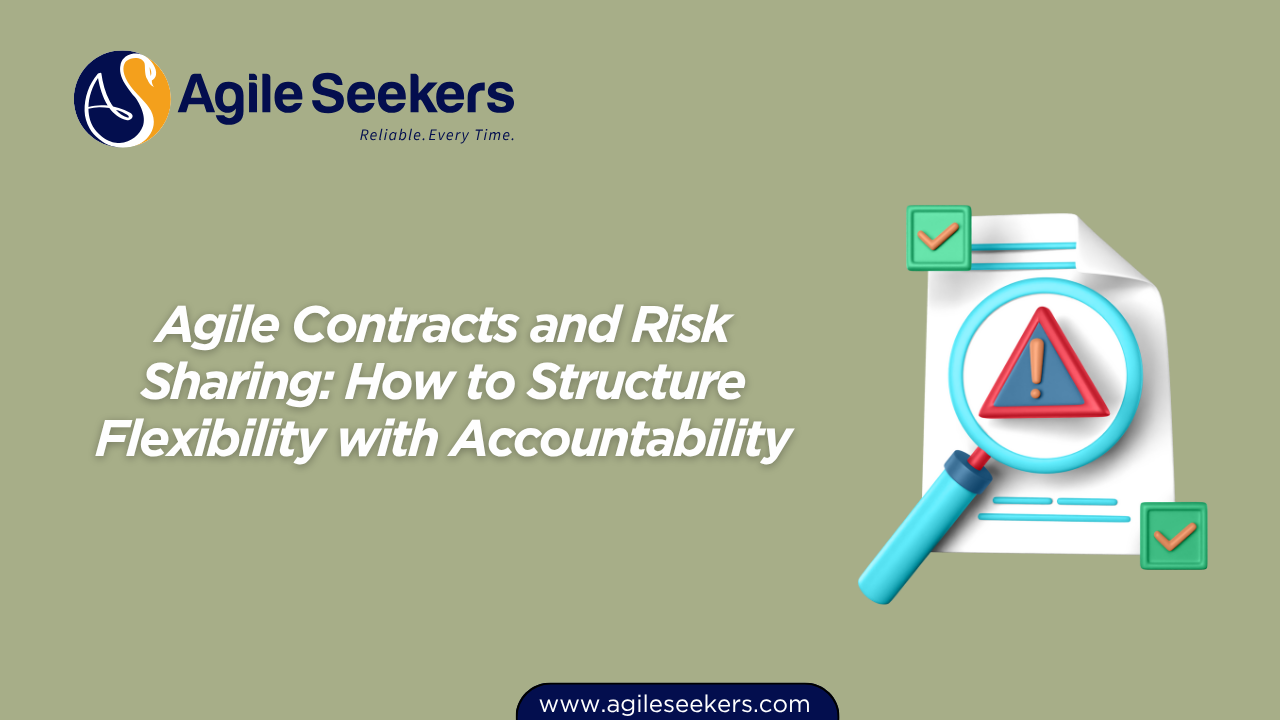Agile Contracts and Risk Sharing: How to Structure Flexibility with Accountability

Traditional contracts often lock all parties into rigid terms, assuming full upfront knowledge of scope, time, and cost. In Agile environments, this approach leads to frequent change requests, delays, and strained relationships. Agile contracts take a different path. They emphasize collaboration, adaptability, and value delivery. However, with flexibility must come shared accountability—this is where risk-sharing in Agile contracts becomes essential.
This post explores how to structure Agile contract terms that promote mutual responsibility while preserving the flexibility Agile demands.
Why Traditional Risk Allocation Doesn’t Work in Agile
In waterfall-style contracts, risk is typically pushed onto the vendor—through fixed-price models or punitive clauses. While it might appear safe for the client, it usually backfires. Vendors inflate costs to cover uncertainty, and when changes arise (as they always do), it leads to friction or rework.
Agile contracts avoid this by:
-
Acknowledging that scope will evolve.
-
Accepting that value is discovered iteratively.
-
Structuring contracts to support continuous learning, rather than punishing deviation.
But how do you embed this mindset into legal agreements?
Key Elements of Risk-Sharing in Agile Contracts
1. Shared Definition of Success
Risk-sharing starts with a common definition of success—not just "on time and on budget," but delivering usable value early and often. This shift allows both client and vendor to collaborate toward outcomes rather than checklists.
2. Incremental Delivery Commitments
Agile contracts typically organize work into time-boxed increments (e.g., 2-week Sprints or Program Increments). Payment and evaluation are tied to actual progress, not projections. This reduces long-term exposure on both sides.
For example, the SAFe® Product Owner/Product Manager (POPM) role plays a crucial part in refining backlog items and aligning deliverables to business value across increments. Learn more about the SAFe POPM certification.
3. Flexible Scope, Fixed Time/Cost
Instead of fixing all three dimensions (scope, time, cost), Agile contracts often fix time and budget, but allow scope to evolve. This is a fundamental Agile principle that lets the team deliver the most valuable items first while managing risk.
4. Incentives Tied to Value, Not Volume
Traditional contracts might pay based on deliverables or lines of code. In Agile, a smarter approach is to tie incentives to business outcomes or customer satisfaction metrics. For example, vendors can receive bonuses for helping increase conversion rates or reducing cycle times.
The SAFe® Advanced Scrum Master role becomes critical in such environments by improving team flow and delivery metrics across teams. Explore SAFe Advanced Scrum Master training for insight into improving predictability in these models.
Common Agile Contract Terms That Support Risk Sharing
| Contract Term | Description |
|---|---|
| Time-boxed Deliverables | Work is structured in Sprints/Iterations with predefined time windows |
| Rolling Wave Planning | Roadmaps and backlogs are updated continuously, not locked at project start |
| Backlog Ownership | Client and vendor co-manage the backlog; priorities can shift as needed |
| Early Termination Clauses | Enables safe exit if collaboration breaks down or value is not delivered |
| Retrospective Clauses | Regular reviews to adapt scope and working agreements |
| Value-based Payments | Payments tied to customer outcomes or delivery of usable features |
This structure gives both parties breathing room to adapt while maintaining a clear sense of ownership and responsibility.
Risk-Sharing Models in Practice
✅ Managed-Investment Contracts
Used in SAFe®, these contracts align funding with specific outcomes, rather than long-term commitments. They enable change without renegotiating the entire contract.
This model is especially relevant for Lean Portfolio Management, where investments are steered based on validated learning. Certified SAFe Agilist professionals play a strategic role here by linking strategy to execution.
✅ Agile + T&M Hybrid
Time-and-Materials contracts can feel open-ended. Adding Agile constraints like capped budget, fixed timelines, or milestone-based payments limits risk. These hybrid models work well for exploratory projects, where full scope isn’t known upfront.
How to Maintain Accountability Alongside Flexibility
Risk-sharing doesn’t mean letting go of accountability. The following practices maintain balance:
-
Transparent Metrics: Use team velocity, lead time, and quality metrics to monitor progress. Tools like Jira, Azure DevOps, and VersionOne provide real-time visibility.
-
Dedicated Scrum Masters: Trained Scrum Masters ensure processes are followed and teams stay on track. If you want to deepen your facilitation and coaching skills, SAFe Scrum Master certification is a valuable path.
-
Formal Retrospectives: These are not optional ceremonies. They are contractual touchpoints where adjustments are made collaboratively.
-
Continuous Involvement from Product Leadership: PO/PM roles are responsible for prioritization and business alignment. Their involvement prevents waste and keeps teams focused on value.
Legal and Compliance Considerations
Agile contracts still need to satisfy legal and regulatory needs. Here's how to bridge the gap:
-
Include IP protection clauses that adapt to evolving deliverables.
-
Define clear responsibilities for data compliance and security controls.
-
Address auditability through traceable value delivery and backlog history.
-
Ensure sign-off models for completed iterations.
For large enterprises coordinating multiple Agile teams, Release Train Engineers (RTEs) play a vital role in aligning delivery with governance. Consider RTE certification if you're responsible for large-scale delivery governance.
Final Thoughts
Structuring Agile contracts with risk-sharing in mind is not just a legal or procurement concern—it’s a cultural shift. It demands transparency, trust, and ongoing collaboration. The goal isn’t to remove risk, but to manage it together.
If you're part of an enterprise Agile transformation, equipping your team with the right roles and skills—like Scrum Masters, Product Owners, and RTEs—can create a foundation for successful risk-sharing. Certifications like SAFe POPM and SAFe Agilist help leaders navigate these dynamics effectively.
Let Agile contracts be more than paperwork—let them be instruments of trust.
Also read - How Agile Contracts Support Lean Portfolio Management and the VMO
Also see - 7 Principles of Agile Contract Design Every Procurement Team Should Know




















